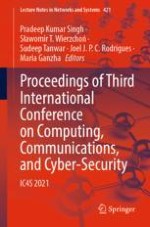2023 | OriginalPaper | Chapter
Dimensionality Reduction-Based Discriminatory Classification of Human Activity Recognition Using Machine Learning
Authors : Manoj Kumar, Pratiksha Gautam, Vijay Bhaskar Semwal
Published in: Proceedings of Third International Conference on Computing, Communications, and Cyber-Security
Publisher: Springer Nature Singapore
Activate our intelligent search to find suitable subject content or patents.
Select sections of text to find matching patents with Artificial Intelligence. powered by
Select sections of text to find additional relevant content using AI-assisted search. powered by
